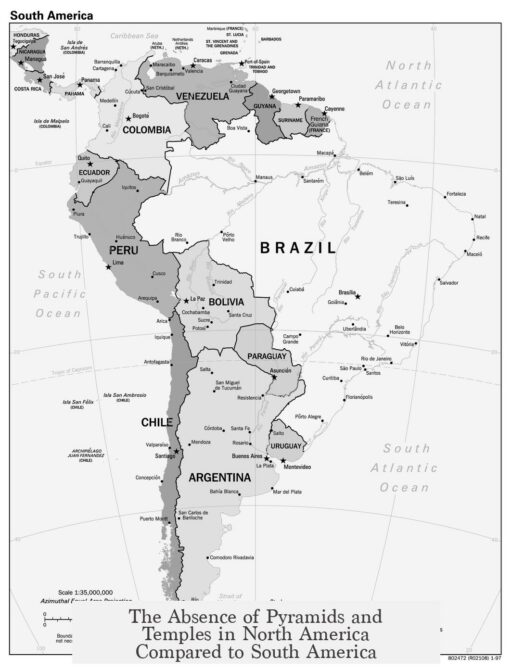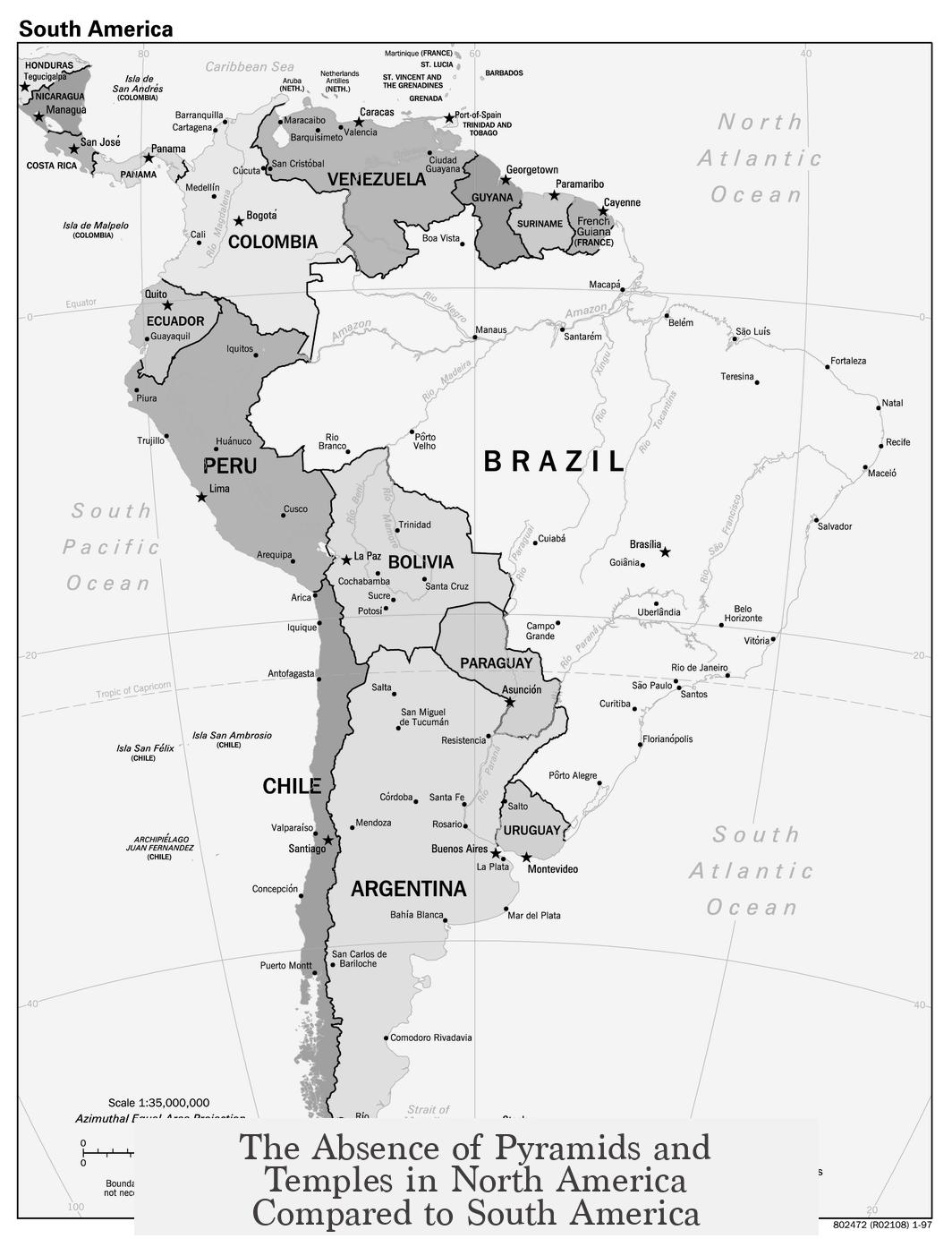Although North America (excluding Mexico) lacks the iconic stone pyramids and temples seen in South America, it actually hosts an extensive tradition of pyramid-building made primarily from earth rather than stone. North America’s pyramidal structures mainly consist of massive earthen mounds built by indigenous cultures, fulfilling similar ceremonial, religious, and political roles as the stone pyramids of South and Mesoamerica.
The earliest pyramids in Mesoamerica, such as the Olmec’s Great Pyramid of La Venta, are large earthen constructions, not unlike North American examples. Across the Gulf of Mexico and into the present-day United States, cultures dating back over 5,000 years built monumental earthworks. For instance, the Watson Brake site in Louisiana has structures over 5,400 years old, which could be considered proto-pyramids. Later, the Poverty Point culture created the Bird Mound about 3,700 years ago, a more classically pyramidal earthen structure larger than the Olmec’s La Venta pyramid.
Many mound-building cultures in North America, such as the Adena, Hopewell, Troyville, and Mississippian, continued this long-standing tradition. Their earthworks include conical burial mounds and flat-topped ramped platform mounds designed as ceremonial centers or elite residences. The Mississippian culture’s Monks Mound at Cahokia, Illinois, stands as the largest known Pre-Columbian earthen pyramid in North America, over 100 feet high.
These flat-topped mounds typically supported wooden or thatch structures used as homes for leaders or temples for religious ceremonies. Unlike the iconic stone temples and pyramids of South America and Mesoamerica, which often featured stone chambers and elaborate facades, North American pyramids functioned as platforms for above-ground buildings. Ceremonial use extended beyond temples to include open plazas and geometric earthworks serving various social or ritual roles.
The apparent lack of stone pyramids or elaborate temples north of Mexico aligns with differences in available materials and religious traditions. While stone was a prominent building material in South America and Mesoamerica, the dense forests and geological conditions in much of North America favored earthworks rather than stone monuments. Additionally, religious and social practices differed significantly. South American pyramids, such as those built by the Inca or Maya, symbolized combined political and religious power, with restricted access to elite priests or royalty. In contrast, many North American cultures practiced religious rituals in more communal or familial settings, like the kivas in the Southwestern US—sunken ceremonial chambers incorporated within residential compounds rather than grand public pyramids.
Moreover, Mexico is geographically part of North America and is home to extensive stone pyramid complexes like Teotihuacan, Chichen Itza, and Monte Alban, blurring the simplified notion of “North America” lacking pyramids. The division between the monumental stone pyramids of South and Mesoamerica and the earthen mounds of North America primarily reflects cultural, environmental, and historical distinctions rather than an absolute absence.
Unfortunately, many North American earthen mounds and earthworks have been lost or destroyed due to urban development, agriculture, and archaeological excavation since the 1800s. This loss has contributed to misconceptions about the scale and sophistication of mound-building cultures north of Mexico. Unlike the visually striking stone pyramids that survive in South America, earthen pyramids erode over time and can be difficult to recognize without archaeological study.
| Aspect | North America (Excluding Mexico) | South America |
|---|---|---|
| Primary Pyramid Material | Earth (earthen mounds) | Stone and adobe |
| Notable Cultures | Adena, Hopewell, Mississippian, Troyville | Inca, Moche, Nazca, Tiwanaku |
| Architectural Function | Platforms for temples or elite residences; burial mounds; ceremonial earthworks | Monumental temples and tombs; centers of political-religious power |
| Religious Practices | More communal, familial rituals; private or small-scale ceremonies (e.g., kivas) | Elaborate elite ceremonies; restricted access temples; divine rulership displays |
| Preservation Status | Many partially destroyed, eroded or under-studied | Many well-preserved stone complexes |
- Mesoamerican pyramids and South American temples use stone, whereas North American pyramids employ earth.
- Religious and political structures differ, influencing architectural choices.
- North America has pyramids but in earthen form, often topped with wooden structures.
- Destruction of sites and differing materials led to under-recognition of North American pyramids.
- Mexico spans North America and contains many stone pyramids, bridging the architectural distinction.
This analysis shows that North America does not lack pyramids or temples, but rather has a different tradition of sacred architecture centered on earthen mounds, shaped by environmental resources and cultural priorities.
Why are there no pyramids or temples in North America, but there are so many in South America?

It’s a common misconception that North America is void of pyramids or temples simply because it lacks the grand stone structures seen in South America or Mesoamerica. In truth, North America, especially the region north of Mexico, is dotted with numerous earth pyramids and mounds that performed similar cultural and religious functions but differ in appearance and material. Let’s unpack this fascinating architectural and cultural mystery.
Imagine walking across the lush landscapes of the ancient Mississippi Valley or Louisiana thousands of years ago. Instead of stone pyramids rising sharply against the skyline, you’d find giant earthen mounds shaped meticulously by hands over generations. These are the pyramids of North America—earthy and expansive rather than towering and stony.
North American “Pyramids” Aren’t What You Expect

When most people think of pyramids, they visualize the iconic Egyptian stone pyramids or the stepped stone pyramids of the Maya and Aztec in South America and Mexico. But in contrast, North America north of Mexico primarily hosts earthen pyramids and mounds rather than stone. The tradition here is ancient and vast, but it favors soil over stone.
Take the Great Pyramid of La Venta in Mesoamerica for example. It’s a giant earthen pyramid dating back thousands of years. Now hop across the Gulf of Mexico to Louisiana, where the Watson Brake site, built 5400 years ago, represents some of the oldest mound structures in the Americas. Debate swirls among scholars whether to call these true pyramids or proto-pyramids. Regardless, the Bird Mound of Poverty Point, about 3700 years old, stands as a grand, classic pyramid form made entirely of earth, even larger than some Olmec counterparts.
In fact, sites like Poverty Point and later Troyville Earthworks in Louisiana exemplify this ancient earthen pyramid tradition, passed down through cultures like the Hopewell and Mississippians. The crowning achievement? Monks Mound at Cahokia, Illinois — the largest prehistoric earthen pyramid in North America. It’s massive, flat-topped, and distinctive in its earthen construction.
So, What About Temples? Were There No Religious Centers?

The answer is: there were, but their architectural style defies the stone temple stereotype. Historical records and archaeological data suggest that many of these mounds had flat tops where wooden temples, homes of local leaders, or ceremonial structures once stood. These temples, unlike those in stone-bound South America, were often ephemeral and built atop earth mounds.
For example, in the Hooded enigmatic sites like Etowah and Moundville, wooden platforms seated temples and elite residences signaling social and political hierarchies. Furthermore, earthworks and mounds functioned as ceremonial grounds, serving the spiritual needs of communities even without grand stone monuments.
Religious Traditions Shape Architecture: A Tale of Two Continents

Why the difference? Distinct religious customs and political structures played massive roles. South American pyramids, especially in the Yucatan and Andean regions, often symbolize intertwined religious and political power, emphasizing elite performances and displays. Their towering stone pyramids housed kings during coronations and priests during rituals. Public plazas bristled with altars glorifying rulers, while commoners took the sidelines.
In contrast, many North American religious practices favored more private ceremonies. Take the; Kiva—a sunken, covered, circular room found in the southwestern U.S. These Kivas were intimate, enclosed ceremonial spaces, reflecting a different religious sensibility. Imagine wanting to hold a private family ceremony or secret gathering in the middle of a giant open plaza—that wouldn’t fly here.
This divergence in religious practice meant architecture adapted accordingly. Stone monuments could proclaim divine authority publicly—a useful statement in politically turbulent times—but smaller, enclosed earth mounds and wooden temples suited other, more communal or private spiritual traditions.
Not All of North America Is Void of Stone Temples
A quick geography lesson: Mexico is part of North America. And yes, Mexico boasts the iconic stone pyramids of Teotihuacan, Chichen Itza, and more. The distinction often mistakenly made is that “North America” means just the U.S. and Canada, but the continent includes Mexico, where Mesoamerican civilizations used both earthen and stone pyramid traditions intensely.
North of Mexico, the scarcity of stone pyramids is linked mostly to resource availability, society size, and cultural choices rather than an absence of monumental or sacred architecture altogether.
What Happened to These Earthen Pyramids in North America?
Sadly, the story of North American earthen mounds is often one of loss and neglect. Many of these remarkable structures suffered destruction over the last two centuries. In the 1800s and beyond, urban development, farming, and even early archaeological excavations often destroyed or damaged these sites.
This destruction helped fuel the myth that so-called “North America” lacked such ancient monumental architecture. The reality is that many of these earth mounds remain hidden under layers of history and vegetation, less impressive on the surface than stone pyramids, but no less significant historically.
A Quick Summary Table Shows the Key Differences
| Feature | North America (north of Mexico) | South America (and Mesoamerica) |
|---|---|---|
| Material | Primarily earth (soil, clay, sometimes wood on top) | Predominantly stone and stone masonry |
| Structure Type | Flat-topped earthen pyramids, conical mounds, Kivas (sunken structures) | Tall stepped stone pyramids with enclosed chambers |
| Religious Style | More private or community-oriented, often with wooden temples atop mounds | Elite-focused ceremonies with visible, grand displays of power |
| Preservation Challenges | Many lost due to agriculture, construction, early archaeology | Survive largely due to durable stone and protected archaeological sites |
What Can We Learn From These Differences?
Human societies build according to culture, environment, and needs. If you only equate pyramids with stone, you miss a whole world of innovation. The earthen mounds of North America are no less impressive architecturally or culturally. They reveal complex social orders, political power, and religious meaning adapted to local values.
Next time you think of pyramids, remember: the story isn’t just about towering stone temples. Sometimes, it’s about centuries of patient hands shaping earth, creating spiritual centers that lasted thousands of years until forgotten by popular imagination.
Curious to explore more? Archaeological resources like Reddit’s r/AskHistorians have excellent discussions on these topics. They reveal how the material and cultural distinctions reflect deeper stories about indigenous traditions spread across the American continents.




